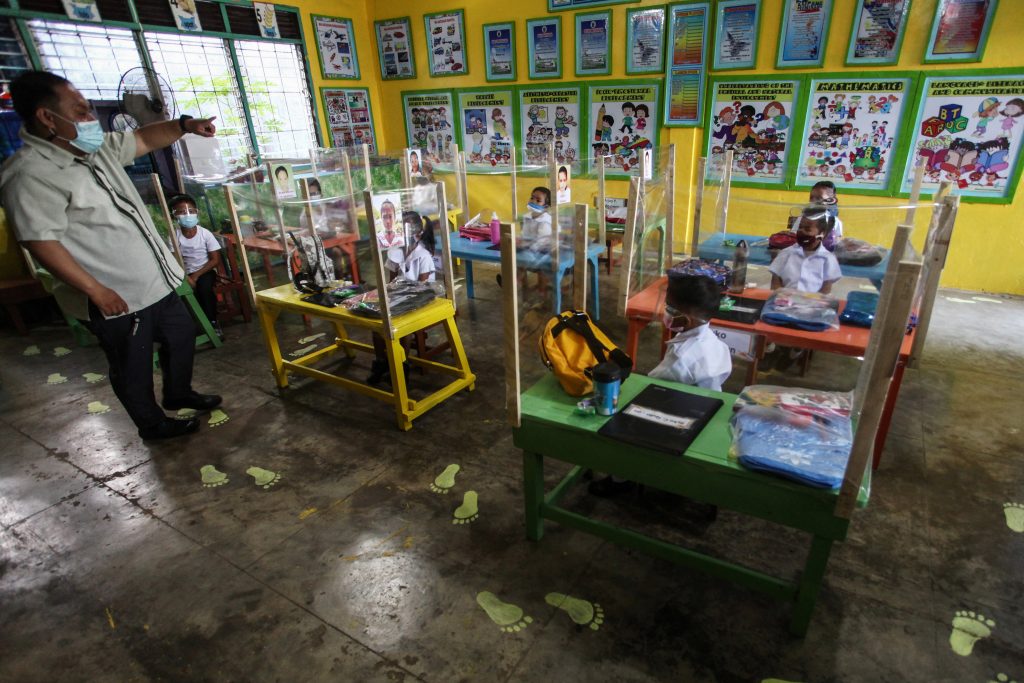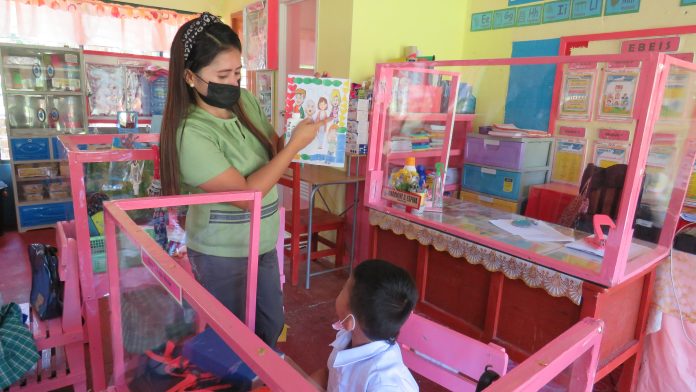An alliance of school teachers protested the reported presence of policemen in schools as face-to-face classes opened in some primary schools in the Philippines on Monday, November 15.
“What are armed policemen doing inside the classrooms?” said Raymond Basilio, secretary general of the Alliance of Concerned Teachers (ACT), in a statement.
Photographs that came out in some online media sites showed police officers carrying long firearms inside classrooms in the province of Pangasinan as schools participates in the pilot run of face-to-face classes.
ACT said the incident could be traumatic to learners and teachers, and is a direct violation of [the Education department’s] “Schools as Zones of Peace” orders.
“It is absurd for [the Education department] to be citing that COVID-19 testing can be traumatic to students, then allow young children now to be subjected to the trauma of being at arms-length with police forces carrying long arms,” said Basilio.
ACT demanded for the immediate pull out of all armed police forces inside the schools for the pilot run of face-to-face learning and called for the deployment of civilian government workers.
Thousands of children were allowed to return to classrooms in some parts of the country for the first time since the start of the pandemic.
While nearly every country in the world has already partially or fully re-opened their schools to face-to-face learning, the Philippines has kept them closed since March 2020.
Kindergarten teacher Zyrex Damayo said he was “a bit nervous” as he greeted eight of his students at the Siocon Elementary School in Bogo city in the central island province of Cebu.
“I was expecting some of them to cry… (but) it went smoothly and we did not have any problems,” Damayo told AFP.
“They were quiet — they’re still a bit shy.”

A hundred public schools out of more than 61,000 have been selected for the two-month trial, which is expected to be expanded in the coming weeks, education officials said.
Many of the schools are located in remote, mountainous or island communities considered to be low risk for virus transmission.
“I cannot guarantee that this will be 100 percent successful, but in our assessment, we have high hopes that this pilot will be a success,” said Education Secretary Leonor Briones last week.
Students in kindergarten, grades one to three, and senior high school are eligible to take part in the trial.
Class sizes are capped and time in the classroom limited, with strict rules on mask wearing, hand washing and social distancing.
A “blended learning” program, which involves online classes, printed materials and lessons broadcast on television and social media, will continue.
Schools in the national capital region also have been pushing to resume face-to-face lessons, but so far they have not received the green light.
Oliver Sanchez, principal of Filemon T. Lizan Senior High School in Navotas City, said most parents wanted their children back in the classroom.
“I think they got tired of teaching their children,” Sanchez told AFP.
Nearly 30 percent of the country’s 110 million people are fully vaccinated against COVID-19, though the rate is almost 70 percent in the capital Manila.
Authorities began rolling out jabs for children as young as 12 this month.
The Philippines has recorded more than 2.8 million infections since the start of the pandemic, but the daily case rate has fallen dramatically in recent weeks.
There have been growing calls from the UN’s children fund and many teachers for a return to in-person learning amid concerns the prolonged closure was exacerbating an education crisis in the country.
Fifteen-year-olds in the Philippines were at or near the bottom in reading, mathematics and science, according to data from the Organization for Economic Co-operation and Development.
Most students attend public schools where large class sizes, outdated teaching methods, lack of investment in basic infrastructure such as toilets, and poverty have been blamed for youngsters lagging behind. – with a report from Agence France Presse









